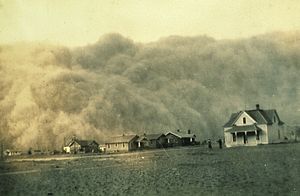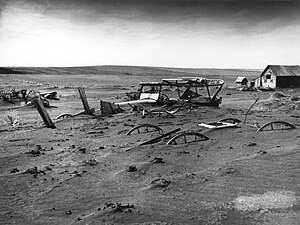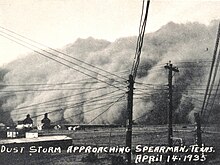Dust Bowl
This article needs additional citations for verification. (June 2007) |


Dust Bowl was a series of dust storms causing major ecological and agricultural damage to American and Canadian prairie lands in the 1930s, caused by decades of extensive farming without crop rotation among cotton, corn and grain farmers using techniques that promoted erosion coupled with severe drought. The fertile soil of the Great Plains was exposed through removal of grass during plowing. During the drought, the soil dried out, became dust, and blew away eastwards, mostly in large black clouds. At times, the clouds blackened the sky all the way to Chicago, and much of the soil was completely lost into the Atlantic Ocean. This ecological disaster caused an exodus from Texas, Arkansas, Oklahoma, and the surrounding Great Plains, with over 500,000 Americans left homeless.[1] Many Americans migrated west looking for work while many Canadians fled to urban areas like Toronto. Some two-thirds of farmers in "Palliser's Triangle", in the Canadian province of Saskatchewan, had to rely on government aid to survive. This was due mainly to drought, hailstorms, and erratic weather rather than to dust storms such as those which were occurring on the U.S. Great Plains farther south.[2] Some residents of the Plains, especially Kansas and Oklahoma, fell prey to illnesses and death from dust pneumonia and the effects of malnutrition.
Overview
The agricultural market was particularly unstable during the 1930s, due to overproduction following World War I. National and international market forces during the war had caused farmers to push the agricultural frontier beyond its natural limits. Increasingly, marginal land that was previously considered unsuitable for use was developed to capture profits from the war.
On November 11, 1933, a very strong dust storm stripped topsoil from desiccated South Dakota farmlands in just one of a series of bad dust storms that year. Then on May 11, 1934, a strong two-day dust storm removed massive amounts of Great Plains topsoil in one of the worst such storms of the Dust Bowl. The dust clouds blew all the way to Chicago where filth fell like snow, dumping the equivalent of four pounds of debris per person on the city. Several days later, the same storm reached cities in the east, such as Buffalo, Boston, New York City, and Washington, D.C. That winter, red snow fell on New England.
On April 14, 1935 known as "Black Sunday", twenty of the worst "Black Blizzards" occurred throughout the Dust Bowl, causing extensive damage, turning the day to night. Witnesses reported that they could not see five feet in front of them at certain points.
Migrations

With their land barren and homes seized in foreclosure, many farm families were forced to leave. The migration was drastic; 15% of the people living in the state of Oklahoma moved to California. Migrants also left farms in Kansas, Texas, and New Mexico, but all were generally referred to as "Okies." Estimates for the number of people displaced range from 300,000 to 2,300,000. [citation needed]
Government response
During President Franklin D. Roosevelt's first 100 days, governmental programs to restore the ecologic balance of the nation were implemented. The U.S. Government was to form the Soil Conservation Service, which is now the Natural Resources Conservation Service (NRCS).
Influence on the arts
The human crisis was documented by photographers, musicians, and authors of the time. Photographer Dorothea Lange made a name for herself while working as a photographer with the Farm Security Administration, capturing the impact of the storms on film. Independent artists like folk singer Woody Guthrie and novelist John Steinbeck both became famous for their depictions of life during the Dust Bowl of the 1930's.
Footnotes
- ^ "First Missed Century:Interview:James Gregory". PBS. Retrieved 2007-03-11.
- ^ ""The Dust Bowl"". CBC. Retrieved 2007-03-11.
Further reading
- The Worst Hard Time: The Untold Story of Those Who Survived The Great American Dust Bowl, Timothy Egan, Houghton Mifflin Company, New York, 2006, hardcover, ISBN 0-618-34697-X.
- The Dust Bowl: Men, Dirt, and Depression, , Paul Bonnifield, University of New Mexico Press, Albuquerque, New Mexico, 1978, hardcover, ISBN 0-8263-0485-0
- Survival in the Storm: The Dust Bowl Diary of Grace Edwards, Dalhart, Texas, 1935, Katelan Janke, Scholastic (September 2002), ISBN 0-439-21599-4
- The Grapes of Wrath, John Steinbeck, The Viking Press. New York First Edition, 1939.
- Out of the Dust, Karen Hesse, Scholastic Signature. New York First Edition, 1997. hardcover (paperback January 1999) ISBN 0-590-37125-8
- The Worst Hard Time, Timothy Egan, Mariner Books, 2006. ISBN 0-618-77347-9
Bibliography
- Woody Guthrie, The (Nearly) Complete Collection of Woody Guthrie Folk Songs, Ludlow Music,New York 1963.
- Alan Lomax, Woody Guthrie, Pete Seeger, Hard-Hitting Song for Hard-Hit People, Oak Pubblications, New York 1967.
- C.Vann Woodward, The Origins of the New South, Louisiana State University Press, 1967.
Discography
- Dust Bowl Ballads, Folkways FH 5213. Rereleased on July 14, 2000 digitally remastered recording by Buddha Records, ASIN: B00004TY8S.
- Library of the Congress Recordings, Elektra 271/2/3. Rereleased on February 14, 1992, digitally remastered recording by Rounder / Umgd, ASIN: B0000002QZ.
See also

- 1936 North American heat wave
- Woody Guthrie
- The Grapes of Wrath
- Great Depression
- Rain follows the plow
- The Plow That Broke the Plains
- Timeline of environmental events
- Dust pneumonia
- Desertification
- Ogallala Aquifer
External links
- NASA Explains "Dust Bowl" Drought
- The Dust Bowl photo collection
- The Dust Bowl (EH.Net Encyclopedia)
- Black Sunday, April 14, 1935, Dodge City, KS
- Wilma Elizabeth McDaniel, an "Okie Poet" who migrated to California during the Oklahoma Dust Bowl.
- The Bibliography of Aeolian Research
- Surviving the Dust Bowl, Black Sunday (April 14, 1935)
